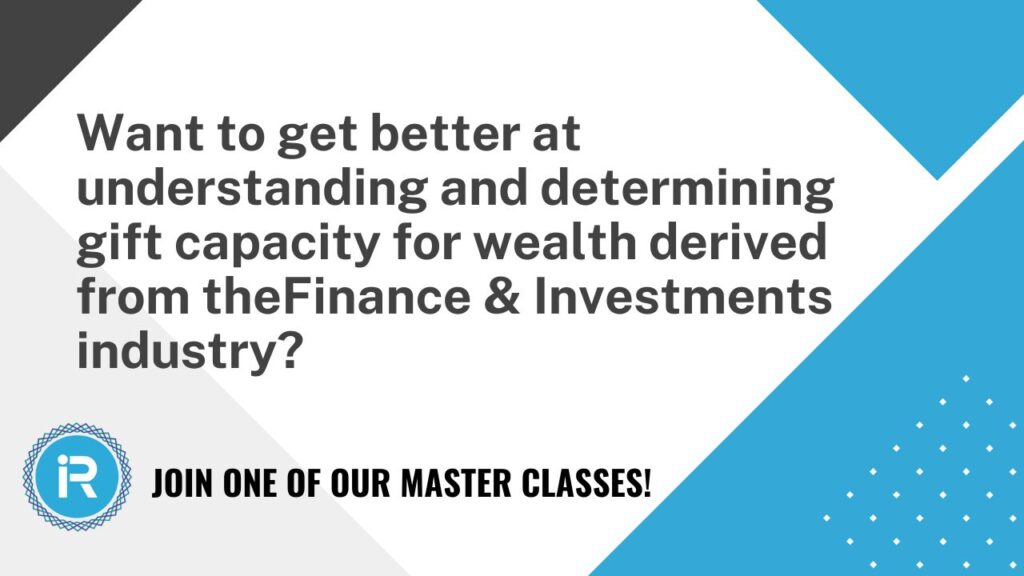Finance Industry Series Part 4 of 5
It can be tough to keep billions quiet. So why is it that although we in prospect research identify people that seem to be likely billionaires, we find them absent from the prominent Forbes listing?
And while I have been focused on the Forbes World’s Billionaires List, the Bloomberg Billionaires Index feels more aligned with us in prospect research – it’s conservatively calculated and the write-up for each individual is presented carefully and quite thoroughly.
In this Finance Industry Series of blog posts, I’ve been focused on our prospects who are rising into the Billionaire Lists because they own or have prominent roles in firms that invest their own and other people’s money in alternative investments, such as hedge funds, private equity, venture capital, investment advisors, and investment banking.
But what about our prospects who are the investors in those alternative investments? (Keeping in mind that this doesn’t completely exclude people at the investment firms.)
Let’s take a peek into how a billionaire list such as Forbes calculates wealth, but more importantly, let’s examine how fundraising research could better help organizations succeed in fundraising from the wealthy by focusing:
- FIRST on Affinity, or love for our organization or cause, and
- SECOND on wealth, for which we should speculate generously.
Will you take my $100 million, please?
If the number of zeroes following the dollar signs is what really holds the interest of fundraising professionals the world over – and it does — we researchers can shape the way in which we present those dollars.
The typical research reaction to this fascination with wealth – as opposed to affinity or philanthropic inclination – is to itemize wealth and assets in the profile that we feel confident explaining and can prove with supporting documentation.
The result? A litany of facts, acronyms, and dollar signs that is boring and says very little about the prospect as a human – giving — being.
Let me bring you back to The Chronicle of Philanthropy’s Philanthropy 50 article, “Meet the Everyday Megadonor” (2023, paywall) featuring Edward Avedisian, a retired clarinetist with the Boston Pops and the Boston Ballet Orchestra – who made a $100 million gift to Boston University.
It’s a fabulous example because there was no public information to suggest Avedisian had the kind of wealth to make a $100 million gift. He lived modestly and gave quietly. The algorithms ignored him. At Aspire Research Group LLC, when someone hits the $1 billion wealth tier, we assign them a $100 million+ gift capacity rating.
Forbes didn’t rank Avedisian. Bloomberg didn’t rank Avedisian.
Even Boston University wasn’t sure about him, but the indicators for affinity were there and his last gift was big enough to warrant attention.
If Avedisian is an outlier that we simply can’t identify proactively, who could we identify that is not ranked and that is a wealth outlier worth paying attention to? And how could we present that information in a way that would attract fundraiser interest?
I am not a statistician, but we could score affinity as a percentage.
Traditionally in prospect research, the gift capacity range is strictly based on wealth. Originally in our field it was taboo to speak of estimated net worth, even though so many of us were already using net worth to estimate gift capacity.
Now the taboo on estimated net worth is gone.
What if we estimated net worth, provided an affinity score as a percentage, and calculated an attainable major gift ask amount range?
Sure, it’s still rife with uncertainty and speculation, but if it was done well and major gift officers felt confident in those ask amount dollar figures, we could accomplish a focus on affinity FIRST while still satiating the brain’s addiction to dollar amounts!
If the major gift officer could push the affinity percentage higher, the gift dollars would also move higher.
Are there research studies on fundamental markers of affinity, starting with giving history? Could organizations receive recommendations on data to collect and track to improve affinity scoring? This is another topic and one for which I have not addressed my attention – yet. (But if you’re already focused on affinity scoring, you could comment!)
Even with a GREAT affinity score, we still need to generously speculate on wealth.
“I asked [Kerry] Dolan [editor at Forbes] what her profile is of a billionaire whom she’d never find. She told me it’s someone who quietly sold a stake in a business for, say, $250 million in the ’90s, then invested it well.” (The New York Times, Apr 2022)
Notice in the quote above how there isn’t a statement of net worth, but more like a story of wealth?
But one must still calculate the value of “stories” such as this. Frequently the business being sold is private and values are not disclosed to the public. Following is an excerpt from Forbes on how it calculates such things for the World’s Billionaires List:
“While some billionaires provided documentation for their assets and companies, others were less forthcoming. To value private businesses, we coupled revenue or profit estimates with prevailing price-to-sales, price-to-earnings or similar ratios for similar public companies and applied a 10% liquidity discount. For venture-backed companies and other businesses that had not recently sold equity to investors, we adjusted based on how the sector in which they operate has fared in the time since their latest funding round.” (Forbes, Feb 2022)
Another great example of telling the story of wealth is the Bloomberg Billionaires Index. Follow me to profile #141 on the index, Donald Newhouse, which has these key sections:
- Overview: Brief statement of where the wealth comes from and a chart demonstrating the value of his wealth over time. Notice how it is trending down?
- Relative Value: Before any juicy details about wealth or personal information, Bloomberg wants us to put Newhouse’s wealth into perspective. Nice.
- Net Worth Summary: In the third section is what many of us are putting first – a litany of facts about his wealth.
- Biography: Finally, the story about Newhouse. We hear about the origins of his life and wealth, how he built the fortune with his brother, and a note on his wife and philanthropy.
We create our own limitations. Free yourself by knowing that whatever and however you estimate, you will always be wrong.
“Both Bloomberg and Forbes consider themselves conservative in their estimates of billionaire wealth. And in fact, there exists yet another billionaire census, done by a research company called Wealth-X, that is considerably less so. In 2021, it counted 927 billionaires in the United States — some 203 more than Forbes did. It doesn’t name any of them. Perhaps they’re right about these 203 unnamed billionaires. Perhaps not. It’s frustrating to not know — to know you can never know for sure — but even more frustrating to know that knowing wouldn’t change a thing about it.” (The New York Times, Apr 2022)
Let the rallying cry for generously speculating wealth be that although we are wrong, “knowing wouldn’t change a thing about it.”
Would you, prospect researcher, have recommended that Boston University’s president dismiss Avedisian, the retired clarinetist, as too low wealth to visit?
Finding the billionaires hiding in your constituency is a worthy adventure, but finding high-affinity donors with some wealth indicators might be a better way to discover the hidden, transformative donor you seek.
Get affinity right + Generously speculate on wealth = More Transformative Gifts
How to get comfortable with not knowing, but generously speculating.
The financial industry, especially the world of alternative investing, is opaque and complex. While I don’t recommend becoming an expert in exactly how to calculate estimated compensation or investment returns, I do recommend understanding enough to generously speculate on your prospect’s wealth.
Join me to learn about complex topics like hedge funds and private equity in a safe environment with opportunities to practice and ask questions.
Check out the Master Classes at the Prospect Research Institute today — and sign up for one that fits what you need to learn.
Additional Resources
- Top of the Wealth List: Finance and Investments? | Finance Industry Series: Part 1 of 5 | Jennifer Filla Blog | 2023
- Alternative Investments: Sophistication Required | Finance Industry Series: Part 2 of 5 | Jennifer Filla Blog | 2023
- The Simple Way to Spot Million-Dollar Donors In Your Database | Finance Industry Series: Part 3 of 5 | Jennifer Filla Blog | 2023
- Affinity First Or ‘Why Is My Prospect Not On The Forbes List?’ | Finance Industry Series: Part 4 of 5 | Jennifer Filla Blog | 2023
- Forbes World’s Billionaires List
- Bloomberg Billionaires Index
- Meet the ‘Everyday Megadonor’: 2022’s List of Top Philanthropists Includes a Host of New Names | The Chronicle of Philanthropy | Feb 2023
- The Forbes 400: Inside how we compile the list of the wealthiest Americans. | Feb 2022
- How Many Billionaires Are There, Anyway? | The New York Times | Apr 2022
- Venture Capital, Private Equity, and Hedge Funds – Don’t hesitate to rate! | by Jen Filla | iWave Blog | 2023
Finance 5 Blog Series
- Top of the Wealth List: Finance and Investments? | Finance Industry Series: Part 1 of 5 | Jennifer Filla Blog | 2023
- Alternative Investments: Sophistication Required | Finance Industry Series: Part 2 of 5 | Jennifer Filla Blog | 2023
- The Simple Way to Spot Million-Dollar Donors In Your Database | Finance Industry Series: Part 3 of 5 | Jennifer Filla Blog | 2023
- Affinity First Or ‘Why Is My Prospect Not On The Forbes List?’ | Finance Industry Series: Part 4 of 5 | Jennifer Filla Blog | 2023
- Can you really turn words into bigger gifts? Yes! | Finance Industry Series: Part 5 of 5 | Jennifer Filla Blog | 2023


2 thoughts on “Affinity first or ‘Why is my prospect not on the Forbes list?’”
Comments are closed.